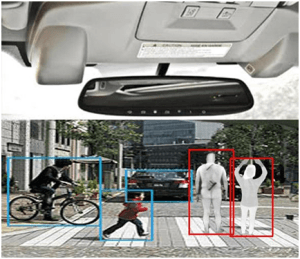Inching forward in heavy traffic toward the ski slopes of Niigata, Japan, Tomohiro Azuma cursed as the car in front stopped suddenly, forcing him to slam on the brakes of his Subaru Legacy.
“There was a voice in my head saying, ‘Damn, too late!’” Azuma, 46, said of the near-collision in February. “Then my car stopped with a jerk and for a moment I didn’t know what had happened.”

The information technology manager from Tokyo had averted a pileup thanks to a feature called EyeSight, which stopped his car when the gap with the vehicle ahead became perilously small. The technology has helped Subaru build a reputation as a leader in safety — typically the domain of high-end brands like Mercedes-Benz and Volvo — and buck falling sales in its home market.
“Subaru may not be the carmaker with the best technology globally, but in Japan it’s No. 1,” said Takashi Morimoto, a consultant at Frost & Sullivan in Tokyo. “Thanks to successful marketing, from the consumer’s point of view, it’s the front- runner.”
The brand, owned by Fuji Heavy Industries Ltd., offers EyeSight as a 100,000-yen ($1,002) add-on in Japan for most of its models. In the first half, about 90 percent of Japan buyers of Subarus that offer the feature opted to install it. That helped the Tokyo-based company boost Japanese deliveries 40 percent from a year earlier, even as the country’s auto market fell 12 percent, according to the Japan Automobile Dealers Association.
Two Cameras
EyeSight monitors traffic via two cameras on either side of the rearview mirror. It can slow the car or brake automatically, and it sounds an alert if there is danger of a collision or the driver is swerving outside the lane.
Subaru says its system is an affordable alternative to those in luxury brands, which often include radars. The company acknowledges that stereo cameras aren’t as precise because they operate much like a human’s eyes. A dirty windshield or rain or snow can hobble EyeSight, and sudden events such as an animal or pedestrian dashing in front of the car are hard for the system to detect immediately.
Subaru introduced EyeSight in May 2010, when it began selling a taller and bigger Legacy to cater to tastes in the U.S., the automaker’s biggest market. For Japan, where roads and parking spots tend to be narrower, Subaru pitched EyeSight as an antidote to buyer concerns that cars as hefty as the new Legacy would be hard to handle on crowded streets.
Local Appeal
“Our salesmen knew a larger size wouldn’t work in Japan,” President Yasuyuki Yoshinaga said in an interview in Tokyo on Aug. 5. “So they decided to try promoting EyeSight aggressively.”
The automaker ran television commercials, held nationwide test drives, and cut the price for the option by half to make it as affordable as replacing a bumper in Japan.
Subaru’s success in boosting sales through EyeSight has spurred other nonluxury automakers to roll out similar features to bolster their safety image and create an extra source of revenue, according to Roland Berger Strategy Consultants. Global sales of such driver assistance systems are expected to more than double from last year to $5.4 billion by 2017, Berger estimates.
Mazda Motor Corp. gives buyers of its revamped Mazda6 the option of technology like EyeSight. About 70 percent of Japanese buyers of the model, released in November, have chosen the option, the company says.
Other Options
Ford Motor Co.’s 2013 Fusion sedan offers a lane-keeping feature, adaptive cruise control and forward-collision warning as extras. Volkswagen AG’s Up! wagon has a standard laser-based emergency-braking system, and Honda’s new Fit, available this month in Japan, will have an auto-stop function similar to EyeSight.
Subaru has yet to sell Eyesight heavily in the U.S., where the brand markets its vehicles as safe and also fun to drive. EyeSight is available on the 2013 Legacy and Outback models as part of a package of extras that can cost more than $4,000. The company says 7 percent of cars sold in the first half in the U.S. had EyeSight.
Subaru says it has no plans to offer EyeSight as a standalone option in the U.S. because capacity constraints at a supplier mean it can’t secure enough components to meet the demand in its home market.
In Japan, EyeSight has helped broaden Subaru’s appeal beyond its core customer base of driving geeks who choose the brand for its low center of gravity and four-wheel-drive prowess.
“I visited dealers before the birth of my kid because the Eyesight offers so many safety features,” said Michihiro Sasaki, 37, who bought a Legacy in 2011. “In the end, I found the car was fun to drive, too.”
(Editors: Lena Lee, David Rocks)
Was this article valuable?
Here are more articles you may enjoy.

 Singer’s Elliott Sued by PE Firm in Escalating Fight Over Money
Singer’s Elliott Sued by PE Firm in Escalating Fight Over Money  Musk’s X Probed by UK Over Grok’s Thousands of Sexualized Images
Musk’s X Probed by UK Over Grok’s Thousands of Sexualized Images  Musk’s xAI Faces California AG Probe Over Grok Sexual Images
Musk’s xAI Faces California AG Probe Over Grok Sexual Images  JPMorgan Wins Gender Pay Gap Dispute Against London Analyst
JPMorgan Wins Gender Pay Gap Dispute Against London Analyst 